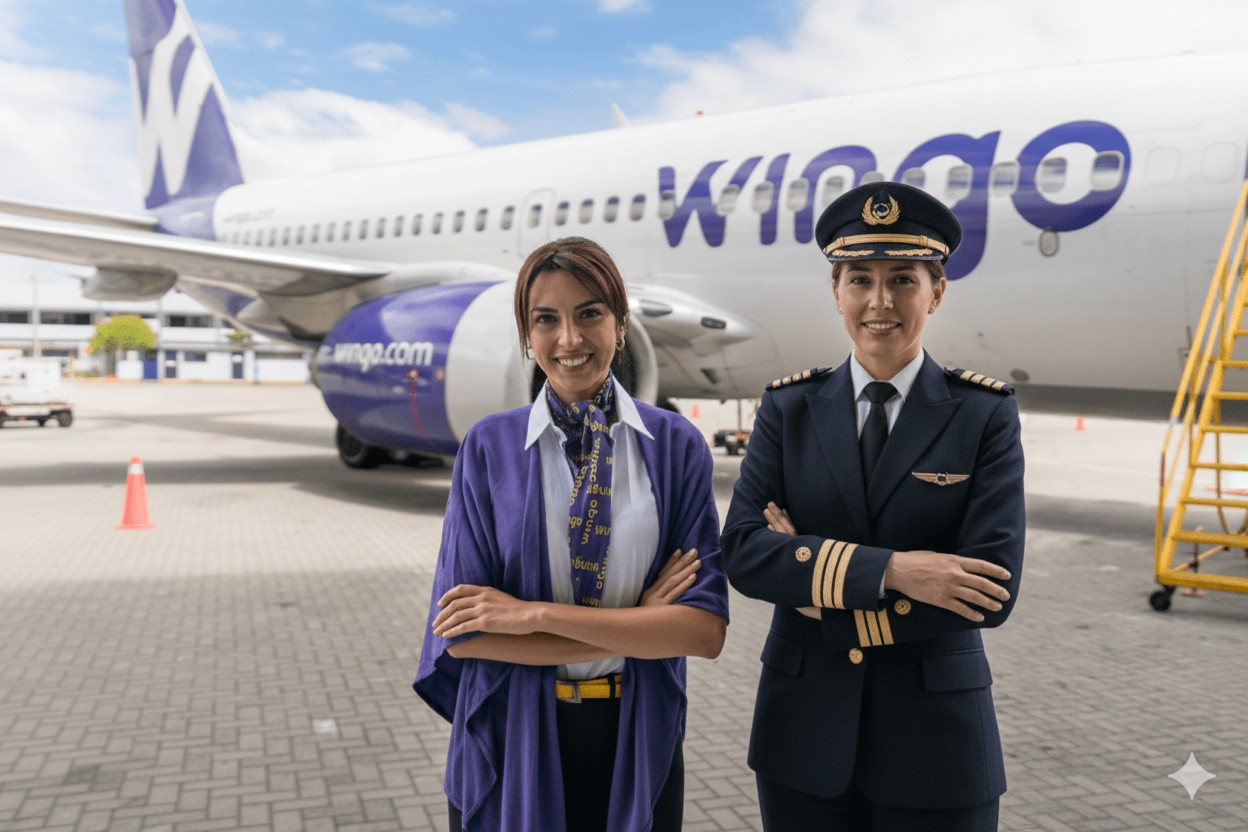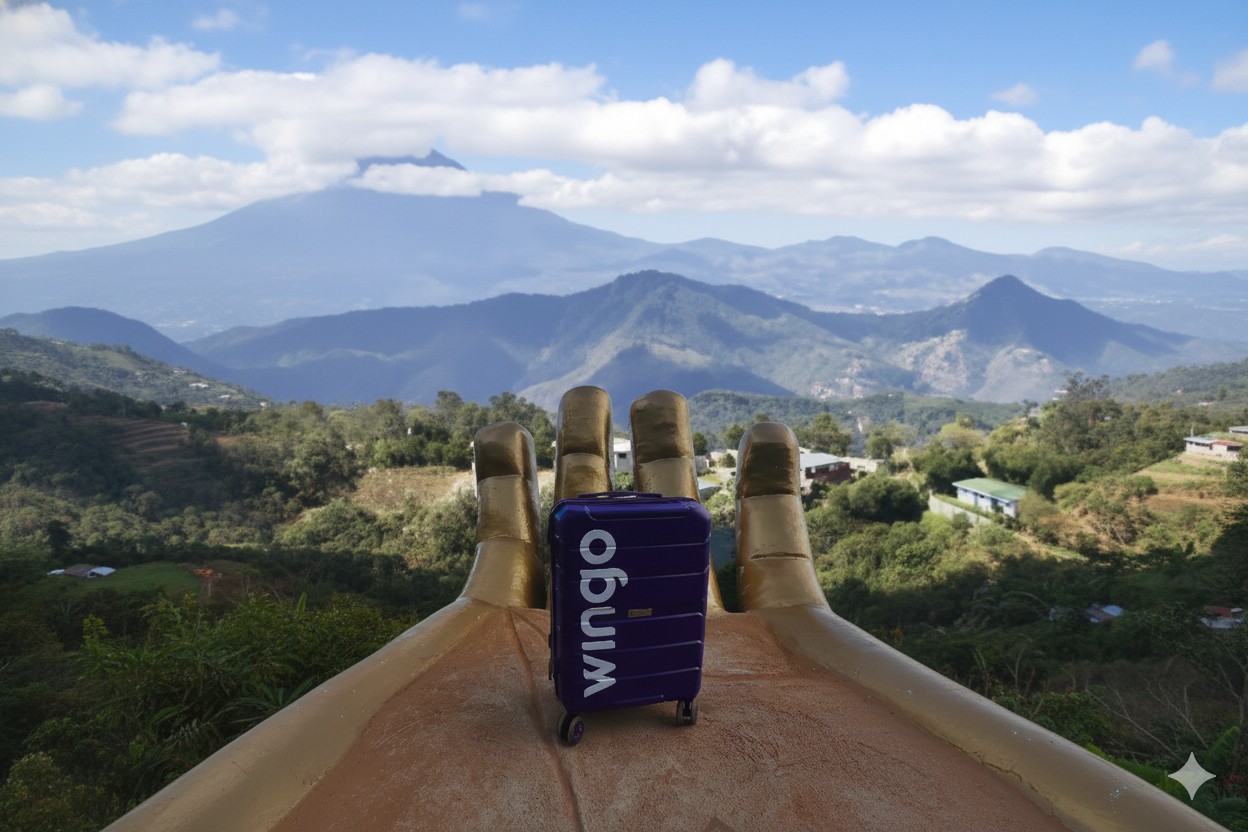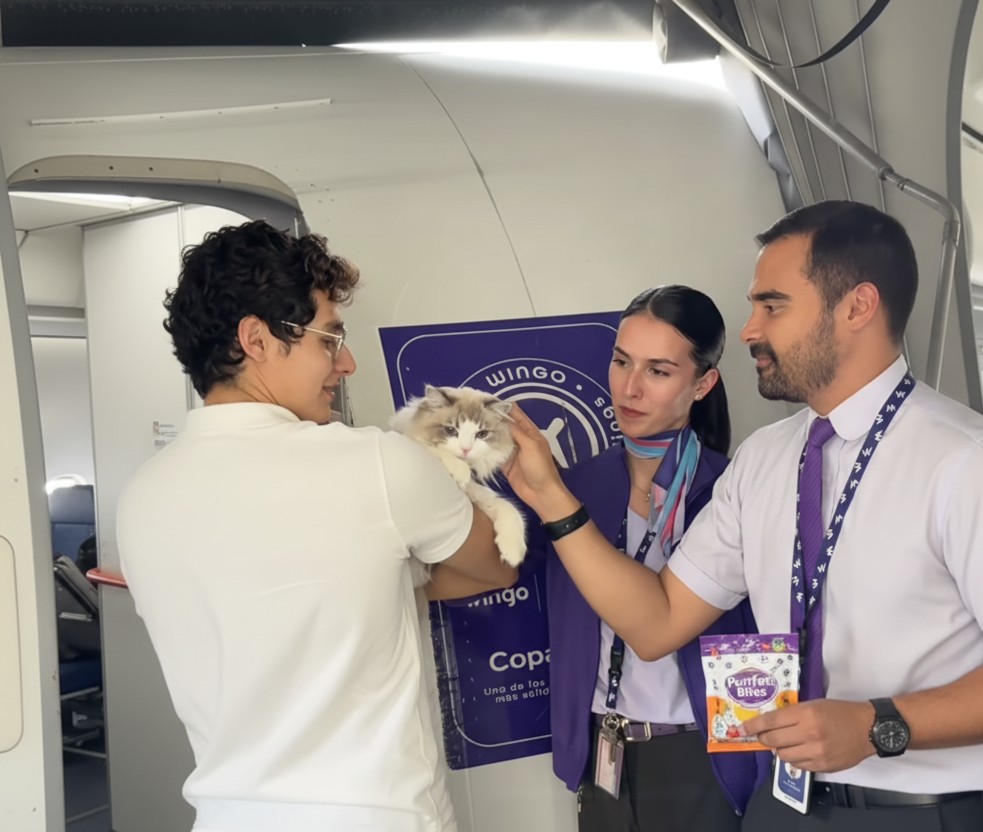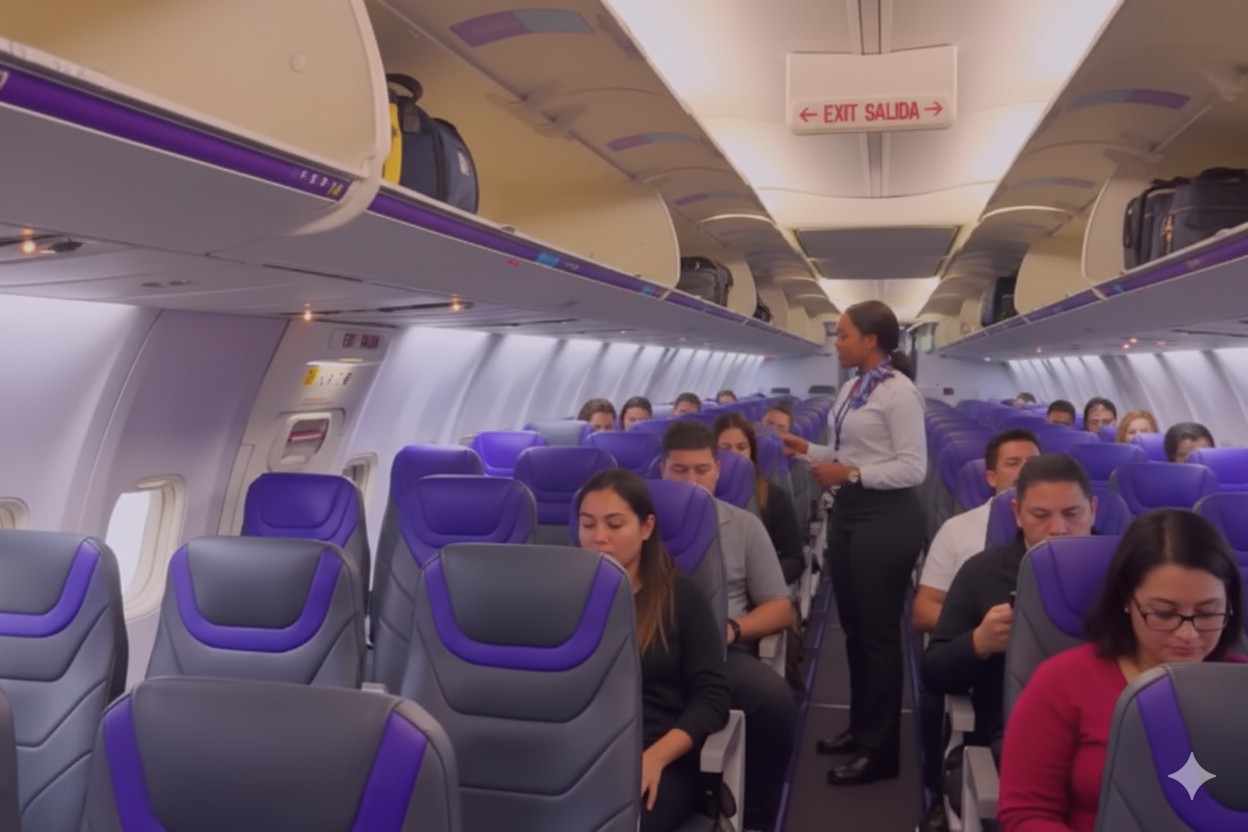October 13, 2025
A Budget Airline That Feels Surprisingly Personal
 When you first hear the name Wingo, it doesn’t sound like an airline—it sounds like a brand of sneakers or an app. But Wingo has quickly become one of Colombia’s most recognizable low-cost carriers, filling the space between major airlines like Avianca and LATAM and smaller regional players such as SATENA.
When you first hear the name Wingo, it doesn’t sound like an airline—it sounds like a brand of sneakers or an app. But Wingo has quickly become one of Colombia’s most recognizable low-cost carriers, filling the space between major airlines like Avianca and LATAM and smaller regional players such as SATENA.
If you’re coming from the U.S., you might compare Wingo to Spirit or Frontier—a no-frills model focused on cheap base fares and optional add-ons. But once you actually fly it, Wingo feels a bit more grounded, a bit more human. Maybe that’s because it’s operated by Copa Holdings, the same company behind Panama’s Copa Airlines, which has a solid international reputation for punctuality and service.
Wingo operates out of Bogotá’s El Dorado International Airport, serving both domestic and international routes across Latin America and the Caribbean. You’ll see its blue-purple planes on runways from Medellín to Mexico City, Panama, and Aruba. It’s an airline designed for travelers who prioritize price and simplicity—but that doesn’t mean it’s careless. If anything, it’s one of the more disciplined budget models in the region.
We flew Wingo to see whether it truly lives up to its promise of affordable, safe, and friendly flying—and how it compares to U.S. budget and legacy airlines.
Booking on Wingo Is Easy—Until You Start Adding Extras
If you’ve ever booked with Spirit or Frontier, Wingo’s system will look familiar. You start with a very low base fare, which looks like an incredible deal. Then, as you go through each booking step, optional charges appear—baggage, seat selection, priority boarding, food, and more.
Wingo uses a model it calls “low-fare, pay-what-you-use.” That means your ticket covers only the flight and a small personal item. Everything else—carry-on, checked bag, snack, seat choice—costs extra.
For a domestic Colombian flight, the difference between base fare and a fully equipped experience can be significant. A $30 ticket might become $60–$80 once you add a carry-on and a checked bag. On international flights (say, Bogotá–Cancún or Bogotá–Panama), the same logic applies, though prices are still competitive against LATAM, Avianca, or U.S. carriers operating the same routes.
The good news is transparency: Wingo’s website and app show each cost clearly. You can choose packages—Basic, Medium, and Full—which bundle extras for better value. The Full option, for example, includes seat selection, carry-on, and checked luggage.
Where some frustration comes in is flexibility. Wingo’s cheapest fares are non-refundable, and even changing dates or names can incur high fees. Like most low-cost airlines, Wingo relies on strict fare rules to keep prices down.
For a U.S. traveler accustomed to Delta’s or United’s refund flexibility—or to having at least one free carry-on—the rigidity might feel limiting. But within the context of Latin American low-cost aviation, Wingo’s structure is clear and consistent.
Baggage: Plan Ahead or Pay Later
 Baggage is the defining feature of any budget airline, and Wingo follows the standard formula: less included, more à la carte.
Baggage is the defining feature of any budget airline, and Wingo follows the standard formula: less included, more à la carte.
Each passenger is allowed one personal item for free—something that fits under the seat, like a small backpack (maximum 6 kg, 40×35×25 cm). If you want to bring a regular carry-on or checked bag, you’ll pay extra.
Carry-on baggage: up to 12 kg and 55×45×25 cm.
Checked baggage: up to 20 kg standard.
Extra weight: additional cost per kilogram.
The key is to prepay online. Buying baggage at the airport can cost double. On Wingo’s app, the “Add Luggage” option is easy to find and cheaper when selected at least 24 hours before departure.
For Americans used to having one free carry-on and one personal item included (as on Delta or United main cabin), this feels restrictive. But for short hops under two hours, the trade-off can be worth it.
We noticed agents weigh both carry-ons and personal items carefully—especially on busy routes like Bogotá–Cartagena or Panama–Bogotá. The enforcement is strict but polite. They’ll often suggest paying right there rather than forcing a bag to be left behind.
It’s part of Wingo’s “budget but courteous” personality: the rules are non-negotiable, but the staff are rarely rude.
Boarding and First Impressions
Boarding with Wingo is organized chaos that somehow works. Their bright purple uniforms and cheerful “¡Bienvenido a bordo!” greetings stand out even on sleepy early-morning flights. The airline uses a single-class layout (all economy), so boarding happens by row or zone, not class.
If you paid for “Wingo Priority,” you can board early and secure overhead bin space. Everyone else follows afterward.
The atmosphere onboard feels casual—music sometimes plays softly while passengers settle in, and you’ll often hear a mix of Spanish, English, and Caribbean accents. It feels youthful, like a Latin version of Southwest Airlines, though without the free bags or humor.
Cabin interiors are modern but minimalist: blue and silver seats, decent legroom (around 30–31 inches pitch), and slimline seatbacks. The planes are mainly Boeing 737-800s, seating around 186 passengers.
Seat Comfort and Cabin Experience
 For short-haul flights, Wingo’s seats are acceptable. They’re not plush, but they’re clean, functional, and designed to maximize space. The padding is minimal yet not uncomfortable. Recline is limited, which actually keeps rows orderly.
For short-haul flights, Wingo’s seats are acceptable. They’re not plush, but they’re clean, functional, and designed to maximize space. The padding is minimal yet not uncomfortable. Recline is limited, which actually keeps rows orderly.
We sat in the middle of the cabin on a Bogotá–Medellín leg and then near the front on a Panama route; the difference was negligible, though seats in the first few rows felt slightly quieter.
Wingo sells “Wingo Extra Space” seats for an additional fee. These have a few more inches of legroom—great for taller passengers or those on 3-hour+ routes.
There are no built-in screens, footrests, or USB ports in older aircraft. Newer 737s sometimes include USB power below the seats, but that’s not guaranteed. You should charge devices beforehand.
For comparison, Delta’s Main Cabin or American’s standard economy offers more consistent amenities (seatback screens, universal power outlets, or USB). United’s narrow-bodies have Wi-Fi and entertainment streaming through the app. Wingo lacks all that, but the trade-off is simplicity: fewer systems mean fewer mechanical issues and faster boarding.
Cabins are usually spotless—no frills, but well maintained. Crew members pass quickly through the aisles after takeoff to verify seat belts and window shades. There’s no feeling of neglect, which says a lot for a low-cost operation.
Food and Beverage: Snack-Bar in the Sky
On Wingo, food isn’t free, but it’s available for purchase. You can choose from a limited buy-on-board menu that includes snacks, drinks, and combos. Prices are reasonable by airline standards: small snacks from around $2 USD and drinks from $3–$5 USD.
The airline offers both Colombian and international favorites—Jet chocolate bars, Club Colombia beer, Pringles, coffee, or instant soups. On international routes, the selection widens slightly.
Crew sell items with handheld devices and card readers (cashless transactions are the rule). The process is efficient, though service pauses occasionally if turbulence hits or the crew must collect trash.
Unlike some budget carriers, Wingo allows outside food, so many locals board with arepas, sandwiches, or small snacks bought in the terminal. The cabin fills with the smell of coffee and baked goods, giving a surprisingly cozy feeling despite the austerity.
If you’re coming from Delta or American, you’ll notice the absence of complimentary water or coffee service. Wingo sells water, though occasionally the crew will provide a free cup if you ask politely.
Onboard Service: Warmth Over Formality
If there’s one area where Wingo outperforms many U.S. low-cost carriers, it’s attitude. Crew members smile, greet passengers personally, and often make small talk in Spanish or English. The friendliness feels authentic, not scripted.
There’s no first class, no elite loyalty tier, and no premium boarding beyond what you pay for. That levels the social tone inside the plane—everyone gets roughly the same treatment.
The airline’s customer-facing culture leans casual but disciplined. Flight attendants enforce rules (baggage, electronics, seat belts) without being harsh. If someone tries to recline too far or switch seats, they handle it with humor.
During our flights, crew made announcements in Spanish first, then English, emphasizing safety but also adding cheerful remarks about destinations: “¡Bienvenidos a Cartagena, la ciudad más linda del Caribe!” It’s a nice local touch that reminds you this is a Colombian airline proud of its routes.
On longer flights, the captain sometimes introduces himself over the PA and gives route updates in both languages—a small but reassuring gesture.
Entertainment and Wi-Fi: Bring Your Own Everything
 There’s no Wi-Fi on Wingo. No streaming portal, no onboard movies, no music channels.
There’s no Wi-Fi on Wingo. No streaming portal, no onboard movies, no music channels.
This might sound like a deal-breaker, but in practice, most Wingo routes are under three hours. Passengers read, sleep, or scroll offline. We recommend downloading your Spotify playlists and Netflix shows in advance, or simply gazing out the window—the Colombian landscape is entertainment enough.
Compared to U.S. airlines, where Wi-Fi and entertainment are ubiquitous (though not always reliable), Wingo’s simplicity can feel refreshing. The cabin stays quiet, and boarding and deplaning move faster because no one’s fiddling with overhead screens.
Still, for business travelers or digital nomads who rely on connectivity, the lack of Wi-Fi is a major drawback.
Delays, Reliability, and Punctuality
Here’s where Wingo earns respect: punctuality. As part of Copa Holdings, the airline inherits some of its parent company’s operational discipline. Industry data from Colombia’s Civil Aeronautics Authority consistently ranks Wingo among the most punctual domestic carriers.
In our own experience, both flights departed within 15 minutes of schedule—rare for a low-cost airline. Turnarounds are efficient, with ground staff moving quickly and announcements made clearly.
That said, cancellations do occur, especially during rainy seasons when smaller airports face visibility issues. Unlike major U.S. carriers with spare aircraft, Wingo has a lean fleet, so rebooking can take time. Passengers may be placed on later flights or offered refunds through vouchers.
Reviews online (TripAdvisor, Airlineratings) note that communication during disruptions is generally polite but sometimes slow, particularly for non-Spanish speakers. The airline’s call centers prioritize Spanish and English, but response times can vary.
Overall, Wingo scores above average for reliability among Latin American low-cost airlines—and better than many U.S. budget carriers in on-time performance.
Safety Record and Fleet Condition
Wingo operates a modern fleet of Boeing 737-800 aircraft, most inherited from Copa Airlines. Average aircraft age is around 15 years, maintained to international standards. Because Copa handles maintenance and compliance, safety levels are strong.
The airline has not recorded major accidents or fatal incidents since its founding in 2016. That’s a key distinction from older Latin American carriers that faced turbulent early years.
Safety protocols mirror those of Copa: standardized briefings, strict crew procedures, and bilingual announcements. You’ll feel the professionalism behind the casual surface.
Compared to Delta, United, or American, Wingo’s safety perception is solid, though its smaller size means fewer redundancies in emergency logistics. Still, for travelers in Colombia, it’s one of the more trustworthy low-cost options.
Comparing Wingo to U.S. Carriers
| Feature | Wingo | Delta / United / American |
| Fare Model | Ultra-low-cost, pay for extras | Tiered economy, often includes carry-on |
| Baggage | Personal item only free; pay for all else | 1 carry-on + 1 personal free |
| Seat Comfort | Slimline, 30–31 in pitch | Similar or slightly better padding |
| Wi-Fi | Not available | Standard on most aircraft |
| Food/Drink | Buy-on-board only | Basic free service (domestic) |
| Customer Service | Friendly but basic | Structured, multilingual |
| Punctuality | Excellent | Variable |
| Fleet Age | ~15 years, all 737-800 | Mixed, 10–15 years average |
| Safety Record | No major incidents | No major incidents |
| Network | Latin America & Caribbean | Global |
The takeaway: Wingo sacrifices extras for punctuality and simplicity. It’s a true low-cost carrier with clean operations and no luxury pretensions.
The Critiques: Where Wingo Falls Short
Even with its strengths, Wingo isn’t perfect. Here are recurring critiques from passengers and our own observations:
- No customer flexibility: Once you buy a basic ticket, changes can be costly. Name corrections, date switches, or cancellations often mean losing most of your fare.
- Hidden-feeling costs: While prices are disclosed, the add-ons can add up fast—carry-on, seat, check-in printing fees (if at the airport). Many first-time users underestimate the total.
- Limited English assistance: At smaller airports, English-speaking staff can be scarce. For foreign travelers, that can cause confusion.
- No Wi-Fi or entertainment: For longer routes (Panama–Bogotá, Bogotá–Lima), the lack of connectivity feels noticeable.
- Customer service delays: Online reviews frequently cite slow email responses and limited chat support hours.
- Strict baggage enforcement: The 6 kg personal-item limit is much smaller than U.S. airlines’ under-seat allowances. Gate enforcement can catch unprepared travelers off guard.
- No loyalty program: Unlike Delta SkyMiles or United MileagePlus, Wingo offers no frequent-flyer system—though rumors of future integration with Copa’s ConnectMiles circulate.
- Sparse in-flight comfort: Seats don’t recline much, tray tables are small, and cabins can get warm if A/C is off at boarding.
Despite these issues, most passengers still rate their experience positively for what they paid. It’s an airline that delivers exactly what it promises: low fares, safety, and punctuality.
What We Appreciated Most
After several Wingo flights, what impressed us wasn’t the comfort or food—it was the efficiency. Every step felt optimized for speed: online check-in worked smoothly, boarding happened on time, luggage arrived quickly.
We also appreciated the human touch in small details. Flight attendants smiled even when enforcing rules, joked with passengers about local weather, and genuinely seemed happy to be flying. There’s warmth beneath the corporate blue.
For short-haul flights within Colombia or to nearby countries, Wingo is often the most convenient choice. The routes are well-timed, and ticket prices remain among the region’s lowest when booked early.
Who Wingo Is Best For
- Budget travelers comfortable with trade-offs.
- Backpackers or weekend flyers carrying minimal luggage.
- Digital nomads moving between Bogotá, Medellín, and Central America.
- Families visiting nearby destinations who plan ahead with baggage bundles.
- Locals or expats who know how to navigate low-cost airline systems.
If you’re expecting Delta-style perks or lounge access, Wingo isn’t for you. But if you’re flexible and organized, it’s a smart, affordable way to explore Latin America.
Our Final Thoughts
Flying with Wingo feels like joining a well-run experiment in Latin America’s growing low-cost market. It’s not trying to impress you with fine dining or plush seats. Instead, it focuses on three things that matter most for budget flyers: price, punctuality, and safety.
Yes, you’ll pay extra for luggage, food, or even printing your boarding pass. But you’ll also likely arrive on time, on a clean plane, with a crew that treats you kindly.
Compared to U.S. low-cost airlines, Wingo holds its own—it’s cleaner than Spirit, friendlier than Frontier, and more disciplined than Allegiant. Compared to legacy U.S. airlines, it’s barebones but refreshingly efficient.
If you know what to expect, Wingo is exactly what it claims to be: a no-frills, trustworthy option for getting around Colombia and its neighbors. The trick is to plan ahead, pack light, and remember that sometimes the best flights are the ones that don’t pretend to be more than they are.
Meet the Team
We’re creators, marketers, and explorers — united by our love for Colombia and passion for storytelling. From content creators and strategists to social media experts and tour managers, we bring your journey — or your brand — to life.
CEO & Founder
Shawn Christopher Leamon
Read More
Social Media Director
Daniel Cardenas
Read More
Operations
Camilo Ceballos
Read More
Graphic Designer
Juan Sierra
Read More
Sales Manager
Juliana Gama
Read More
Social Media Specialist
Dayana Parra
Read More
Sales
Fabian Briñez
Read More
Sales
Johanna Vargas
Read More
Content & Multimedia Strategist
Diana Bustos
Read More
Visual Content Creator
Gabriela Munoz
Read More
Marketing Tours & Content Manager
Sergio Gonzalez
Read More
Storytelling Specialist
Brian Nino
Read More
Finance & Strategy Lead
Fernando Soto
Read More
CEO & Founder
Shawn Christopher Leamon
Read More
Social Media Director
Daniel Cardenas
Read More
Operations
Camilo Ceballos
Read More
Graphic Designer
Juan Sierra
Read More
Sales Manager
Juliana Gama
Read More
Social Media Specialist
Dayana Parra
Read More
Sales
Fabian Briñez
Read More
Sales
Johanna Vargas
Read More
Content & Multimedia Strategist
Diana Bustos
Read More
Visual Content Creator
Gabriela Munoz
Read More
Marketing Tours & Content Manager
Sergio Gonzalez
Read More
Storytelling Specialist
Brian Nino
Read More
Finance & Strategy Lead
Fernando Soto
Read More
